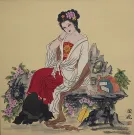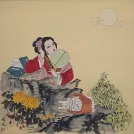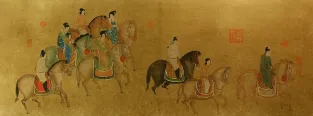Many custom options...
And formats...

The name Tang Dynasty in Chinese / Japanese...
Sorry! There's currently no match for Tang Dynasty in the calligraphy database...
If you want a special phrase, word, title, or proverb, feel free to contact me, and I'll translate your custom calligraphy idea for you.
Below are some entries from our dictionary that may match your tang dynasty search...
| Characters If shown, 2nd row is Simp. Chinese |
Pronunciation Romanization |
Simple Dictionary Definition |
唐 see styles |
táng tang2 t`ang tang tou / to とう |
More info & calligraphy: Donn(1) (hist) Tang dynasty (of China; 618-907); T'ang dynasty; (2) (archaism) China; foreign country; (surname) Touzaki for nothing |
印度 see styles |
yìn dù yin4 du4 yin tu indo いんど |
More info & calligraphy: India(ateji / phonetic) (kana only) India; (place-name) India 印特伽; 身毒; 賢豆; 天竺 Indu (meaning 'moon' in Sanskrit), Hindu, Sindhu; see also 信度 and 閻浮 India in general. In the Tang dynasty its territory is described as extending over 90, 000 li in circuit, being bounded on three sides by the sea; north it rested on the Snow mountains 雪山, i. e. Himālayas; wide at the north, narrowing to the south, shaped like a half-moon; it contained over seventy kingdoms, was extremely hot, well watered and damp; from the centre eastwards to 震旦 China was 58, 000 li; and the same distance southwards to 金地國, westwards to 阿拘遮國, and northwards to 小香山阿耨達. |
魏徵 魏征 see styles |
wèi zhēng wei4 zheng1 wei cheng |
More info & calligraphy: Wei Zheng |
菩提樹 菩提树 see styles |
pú tí shù pu2 ti2 shu4 p`u t`i shu pu ti shu bodaiju; bodaiju ぼだいじゅ; ボダイジュ |
More info & calligraphy: The Tree of Enlightenment / The Bodhi Tree(1) Tilia miqueliana (species of linden tree); (2) (See インドボダイジュ) sacred fig (Ficus religiosa); bodhi tree; bo tree; peepal tree; pipal tree; (given name) Bodaiju bodhidruma, bodhitaru, bodhivṛkṣa; the wisdom-tree, i.e. that under which Śākyamuni attained his enlightenment, and became Buddha. The Ficus religiosa is the pippala, or aśvattha, wrongly identified by Faxian as the palm-tree; it is described as an evergreen, to have been 400 feet high, been cut down several times, but in the Tang dynasty still to be 40 or 50 feet high. A branch of it is said to have been sent by Aśoka to Ceylon, from which sprang the celebrated Bo-tree still flourishing there. |
卿 see styles |
qīng qing1 ch`ing ching kei / ke けい |
high ranking official (old); term of endearment between spouses (old); (from the Tang Dynasty onwards) term used by the emperor for his subjects (old); honorific (old) (pronoun) (1) (honorific or respectful language) (masculine speech) (archaism) (used to address someone of equal or lower status) you; (pronoun) (2) (honorific or respectful language) (archaism) (used by a ruler to address a subject) you; (given name) Akira you |
浣 see styles |
huàn huan4 huan kan かん |
to wash; to rinse; any of three 10-day division of the month (during Tang dynasty); Taiwan pr. [huan3]; also pr. [wan3] (given name) Kan to wash |
溵 see styles |
yīn yin1 yin |
used in place-names, e.g. 溵水 was once the name of the Shahe River 沙河, Henan, and 溵州 was a Tang Dynasty prefecture |
三武 see styles |
sān wǔ san1 wu3 san wu mitsutake みつたけ |
(personal name) Mitsutake The three emperors Wu who persecuted Buddhism: 太武 of the Wei dynasty A.D. 424-452; 武帝 of the Zhou A.D. 561-578; 武宗 of the Tang A.D. 841-7. |
上人 see styles |
shàng rén shang4 ren2 shang jen shounin / shonin しょうにん |
holy priest; saint; (place-name) Shounin A man of superior wisdom, virtue, and conduct, a term applied to monks during the Tang dynasty. |
不可 see styles |
bù kě bu4 ke3 pu k`o pu ko fuka ふか |
cannot; should not; must not (adj-no,adj-na,n,n-suf) (1) wrong; bad; improper; unjustifiable; inadvisable; (adj-no,adj-na,n,n-suf) (2) not allowed; not possible; (3) failing grade; (place-name) Yobazu May not, can not: unpermissible, for-bidden; unable. Buke, the name of a monk of the 靈妙寺 Ling Miao monastery in the Tang dynasty, a disciple of Subha-karāṣimha, and one of the founders of 眞言 Shingon. |
五代 see styles |
wǔ dài wu3 dai4 wu tai godai ごだい |
Five Dynasties, period of history between the fall of the Tang dynasty (907) and the founding of the Song dynasty (960), when five would-be dynasties were established in quick succession in North China (hist) (See 五代十国・ごだいじっこく,後梁・こうりょう,後唐・こうとう,後晋・こうしん,後漢・ごかん・2,後周・こうしゅう) Five Dynasties (of China; 907-979); (p,s,f) Godai |
五時 五时 see styles |
wǔ shí wu3 shi2 wu shih goji |
(五時教) The five periods or divisions of Śākyamuni's teaching. According to Tiantai they are (1) 華嚴時 the Avataṃsaka or first period in three divisions each of seven days, after his enlightenment, when he preached the content, of this sutra; (2) 鹿苑時 the twelve years of his preaching the Āgamas 阿含 in the Deer Park; (3) 方等時 the eight years of preaching Mahāyāna-cum-Hīnayāna doctrines, the vaipulya period; (4) 般若時 the twenty-two years of his preaching the prajñā or wisdom sutras; (5) 法華涅槃時 the eight years of his preaching the Lotus Sutra and, in a day and a night, the Nirvana Sutra. According to the Nirvana School (now part of the Tiantai) they are (1) 三乘別教 the period when the differentiated teaching began and the distinction of the three vehicles, as represented by the 四諦 Four Noble Truths for śrāvakas, the 十二因緣 Twelve Nidānas for pratyekabuddhas, and the 六度 Six Pāramitās for bodhisattvas; (2) 三乘通教 the teaching common to all three vehicles, as seen in the 般若經; (3) 抑揚教 the teaching of the 維摩經, the 思益梵天所問經, and other sutras olling the bodhisattva teaching at the expense of that for śrāvakas; (4) 同歸教 the common objective teaching calling all three vehicles, through the Lotus, to union in the one vehicle; (5) 常住教 the teaehmg of eternal life i. e. the revelation through the Nirvana sutra of the eternity of Buddhahood; these five are also called 有相; 無相; 抑揚; 曾三歸—; and 圓常. According to 劉虬 Liu Chiu of the 晉 Chin dynasty, the teaching is divided into 頓 immediate and 漸 gradual attainment, the latter having five divisions called 五時教 similar to those of the Tiantai group. According to 法寶 Fabao of the Tang dynasty the five are (1) 小乘; (2) 般着 or 大乘; (3) 深密 or 三乘; (4) 法華 or 一乘; (5) 涅槃 or 佛性教. |
伊州 see styles |
yī zhōu yi1 zhou1 i chou |
Tang dynasty province in modern Xinjiang, around Hami 哈密[Ha1 mi4]; Illinois (US state) |
供帳 供帐 see styles |
gōng zhàng gong1 zhang4 kung chang kuchō |
The Tang dynasty register, or census of monks and nuns, supplied to the government every three years. |
傳奇 传奇 see styles |
chuán qí chuan2 qi2 ch`uan ch`i chuan chi |
legendary; fantasy saga; romance; short stories of the Tang and Song Dynasty |
元曉 元晓 see styles |
yuán xiǎo yuan2 xiao3 yüan hsiao Gangyō |
Yuan-hsiao, a famous Korean monk who traveled, and studied and wrote in China during the Tang dynasty, then returned to Korea; known as 海東師 Hai-tung Shih. |
光寳 see styles |
guāng bǎo guang1 bao3 kuang pao |
Two noted monks of 大慈恩 T'zu-en monastery under the Tang dynasty, 普光 P'u-kuang and 法寳 Fa-Pao, the first the author of 倶舍論記, the second of a commentary 疏 on the same śāstra, each in 30 juan. |
兵部 see styles |
bīng bù bing1 bu4 ping pu heibu / hebu へいぶ |
Ministry of War (in imperial China) (hist) (See 六部) Ministry of War (Tang dynasty China); (surname) Hiyoubu |
刑部 see styles |
xíng bù xing2 bu4 hsing pu keibu / kebu けいぶ |
Ministry of Justice (in imperial China) (hist) (See 六部) Ministry of Justice (in Tang dynasty China); (surname) Keibe |
劉昫 刘昫 see styles |
liú xù liu2 xu4 liu hsü |
Liu Xu (887-946), politician in Later Jin of the Five Dynasties 後晉|后晋[Hou4 Jin4], compiled History of Early Tang Dynasty 舊唐書|旧唐书[Jiu4 Tang2 shu1] |
北史 see styles |
běi shǐ bei3 shi3 pei shih hokushi ほくし |
History of the Northern Dynasties, fifteenth of the 24 dynastic histories 二十四史[Er4 shi2 si4 Shi3], compiled by Li Yanshou 李延壽|李延寿[Li3 Yan2 shou4] in 659 during Tang Dynasty, 100 scrolls (given name) Hokushi |
南史 see styles |
nán shǐ nan2 shi3 nan shih nanshi なんし |
History of the Southern Dynasties, fourteenth of the 24 dynastic histories 二十四史[Er4 shi2 si4 Shi3], compiled by Li Yanshou 李延壽|李延寿[Li3 Yan2 shou4] in 659 during Tang Dynasty, 80 scrolls (given name) Nanshi |
南山 see styles |
nán shān nan2 shan1 nan shan nanzan なんざん |
Nanshan or Namsan, common place name; Nanshan district of Shenzhen City 深圳市, Guangdong (1) southern mountains; mountains to the south; (2) (See 北嶺・1) Mount Kōya (esp. Kongōbu-ji); (place-name, surname) Minamiyama Southern hill, name of a monastery which gave its name to 道宣 Tao-hsuan of the Tang dynasty, founder of the 四分律 school. |
南泉 see styles |
nán quán nan2 quan2 nan ch`üan nan chüan minamiizumi / minamizumi みなみいずみ |
(place-name) Minamiizumi Nan-ch'uan, a monk of the Tang dynasty circa 800, noted for his cryptic sayings, inheritor of the principles of his master, Ma Tsu 馬祖. |
古風 古风 see styles |
gǔ fēng gu3 feng1 ku feng kofuu / kofu こふう |
old style; old custom; a pre-Tang Dynasty genre of poetry aka 古體詩|古体诗[gu3 ti3 shi1] (noun or adjectival noun) old-fashioned; archaic; antique; antiquated; (female given name) Kokaze |
吏部 see styles |
lì bù li4 bu4 li pu rihou / riho りほう ribu りぶ |
Ministry of Appointments (in imperial China) Ministry of Personnel (Tang-dynasty China) |
呂岩 吕岩 see styles |
lǚ yán lu:3 yan2 lü yen |
Lü Yan (lived c. 874), Tang dynasty poet |
周書 周书 see styles |
zhōu shū zhou1 shu1 chou shu |
History of Zhou of the Northern Dynasties, twelfth of the 24 dynastic histories 二十四史[Er4 shi2 si4 Shi3], compiled under Linghu Defen 令狐德棻[Ling2 hu2 De2 fen1] in 636 during Tang Dynasty, 50 scrolls |
唐代 see styles |
táng dài tang2 dai4 t`ang tai tang tai toudai / todai とうだい |
Tang dynasty (618-907) (hist) (See 唐・1) Tang period (China; 618-907); Tang era |
唐僧 see styles |
táng sēng tang2 seng1 t`ang seng tang seng |
Xuanzang (602-664) Tang dynasty Buddhist monk and translator, who traveled to India 629-645 |
Click here for more tang dynasty results from our dictionary
This in-stock artwork might be what you are looking for, and ships right away...
Tang Dynasty Beautiful Chinese Woman Painting
Discounted Blemished
Gallery Price: $107.00
Your Price: $59.00
Gallery Price: $180.00
Your Price: $99.88
Gallery Price: $180.00
Your Price: $99.88
Gallery Price: $150.00
Your Price: $79.88
Gallery Price: $100.00
Your Price: $59.88
Successful Chinese Character and Japanese Kanji calligraphy searches within the last few hours...










